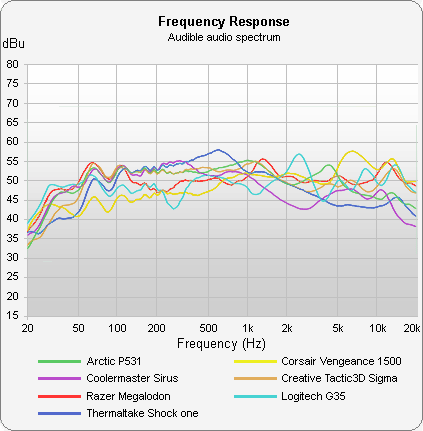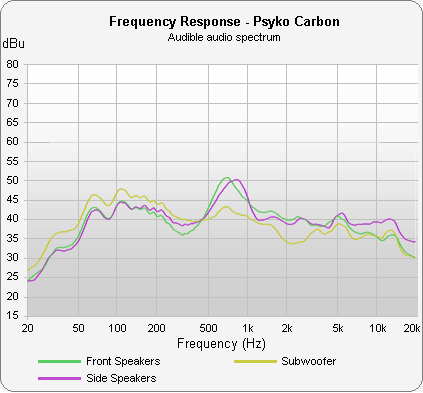Eight 5.1- And 7.1-Channel Gaming Headsets, Reviewed
Surround sound headsets are often more practical than a home theater system attached to your PC. We compare eight premium models from Arctic, Psyko, Cooler Master, Logitech, Creative, Thermaltake, Corsair, and Razer to figure out who sells the top option.
Benchmark Results: Frequency Response And Microphone Quality
We’re going to start with the objective benchmarks, and since these measurements don't show up on Tom's Hardware every day, we're going to give you a little background information first.
Perhaps the best way to understand speaker frequency response is to learn how it is measured. An audio signal is played over the speakers; it’s a signal that equally covers the entire audio spectrum at the same level. The speaker output is then measured across the part of the spectrum that humans can hear, from 20 Hz to 20 kHz. The resulting data turns into the product's tested frequency response. A perfect speaker in perfect conditions would generate a completely flat response line, reflecting the test signal. Peaks and valleys in the graph mean that the speaker isn’t playing back all portions of the audio spectrum equally.
Granted, testing headsets presents unique challenges. In order to simulate the most accurate listening experience, we implanted our microphone into the ear of a test dummy. Unlike full-sized speakers, there is no theoretically-perfect response curve for headphones. Ideally, though, we’ll see slight curves that don’t accentuate or mute parts of the audio spectrum. Keep in mind that our frequency response measurements are most useful as a comparison between the headsets we’re testing, and not as absolute representations of a reference response.
Before we present the results, here’s a quick legend of the audio spectrum:
- The sub-bass range is from 20 to 60 Hz, and it isn’t heard so much as it's felt. Sound in this range provides a sense of power.
- The bass range is from 60 to 250 Hz. This is where you can hear the bass rhythm, especially between 90 to 200 Hz.
- The lower mid-range is from 250 to 500 Hz. This is also called the bass presence range.
- The mid-range is from 500 Hz to 2 kHz. This is where you can hear instruments and vocals.
- The upper mid-range is from 2 kHz to 4 kHz. Higher instruments and most vocals are heard here, and the human ear is very sensitive to changes in this range.
- The presence range is from 4 kHz to 6 kHz. Too little sound in this range will make the audio seem like it’s coming from further away.
- The brilliance range is 6 kHz to 20 kHz. This is where you hear harmonics and clarity, and accented sound in this range makes it seem crisper and clearer with higher fidelity.
Here are the frequency responses of the products in our round-up. All were tested with flat equalizer settings and enhancements turned off.
Compared to a speaker's frequency response, the range is much tighter, with only about 25 dB or so between the maximum and minimum levels. The whole playing field demonstrates a lot of bumps higher and dips lower, so it's hard to extract a lot of useful data in one glance.
A few models show some unique traits, though. Logitech's G35 varies most widely at the upper end of the spectrum, while Corsair's Vengeance 1500 is admirably flat until it hits a notable peak in the higher range.
Note we didn’t include Psyko's Carbon in the first chart, as we needed to test all of it's two-channel analog mini-plugs separately via analog output:
This headset sees a big peak in the mid-range section and a lower bass curve than its competition.
Now, bear in mind that all of these headsets, except for Razer's Megalodon and Psyko's Carbon, feature a software-based graphic equalizer able to adjust frequency response to taste. And the Carbon's analog connections give it access to whatever software your sound card uses to alter output. Thus, a slight bump in the spectrum is not a game-ender for any of these products. Our subjective analysis is arguably more important; at the same time, we thought it important to provide some hard data on each headset at its default settings.
Before we move on, though, we'd like to let you listen to the audio quality you can expect from the microphones attached to these headsets. We recorded a voice test with each model for you to hear yourself. This isn't representative of the sound quality you'd hear while wearing the headset, but it is what your teammates or opponents will hear. And of course, you're limited by the fidelity of your speakers. We're also including any voice effects bundled with the headset, taking each audio avatar out for a test drive. Please set playback to 720p for the best possible quality.
Current page: Benchmark Results: Frequency Response And Microphone Quality
Prev Page Test Setup And Benchmarks Next Page Subjective Testing And ConclusionGet Tom's Hardware's best news and in-depth reviews, straight to your inbox.
Don Woligroski was a former senior hardware editor for Tom's Hardware. He has covered a wide range of PC hardware topics, including CPUs, GPUs, system building, and emerging technologies.


